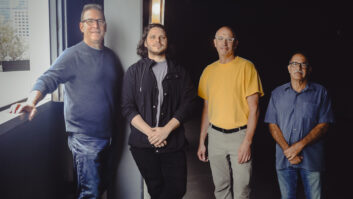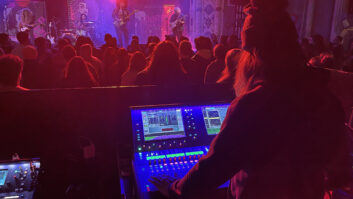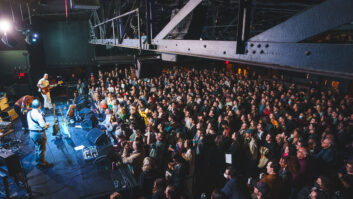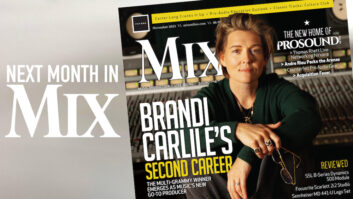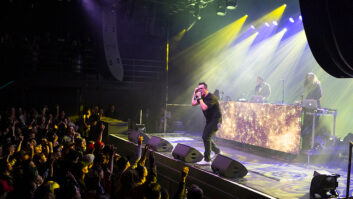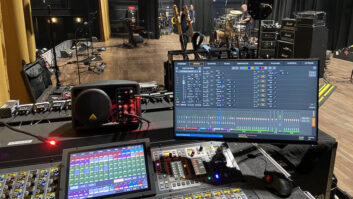It’s an only-in-L.A. kind of thing: A multimillion-dollar new club, smack in the middle of the West Hollywood neighborhood known as Boys’ Town, that’s become a total (female!) babe magnet. Moomba, housed in what was formerly Luna Park, is a rambling, multilevel venue that caters to the beautiful people, with a top-rated restaurant, lounges wired for video and surround sound, a patio, and a cozy performance space with a high-quality sound system.
In L.A.’s trendy and competitive club scene, celebrity sightings are the name of the game. Moomba’s buzz was enhanced when it hosted Elton John’s Oscar night post-awards party, where a Yorkville Sound TX Series P.A. debuted in the main club space.
Seemingly, no expense was spared to outfit the audio/video elements of the club. Panasonic Plasma screens and DVD players abound; monitoring in the sound booth is on Genelec 1031As; and there’s even a digital audio recording system for the bands. The main console, a Sony DMX-R100, is set up for 24 mic inputs and eight monitor mixes; in addition to routing FOH sound, monitors and various feeds throughout the complex, the desk also sends signal, via ADAT Lightpipe, to a Pro Tools MixPlus|24 system archived on removable Glyph drives housed in a four-space Glyph Trip rack. The extensive mic collection, all by Shure, includes wireless, SM44 and the complete Beta Series.
According to Andrew Lunsford, Moomba’s perpetually-in-motion sound technician, the club hosts all sorts of events, and the 200-capacity performance room, with its corner stage, is readily reconfigured. Some nights, carpet and couches appear and a digital video projector drops down, creating a viewing room for 5.1 DVD movies. For DJ nights, it becomes a dance floor with a lounge and mirror balls. There are private events, and sometimes the room gets transformed into a small theater — complete with a runway — for fashion shows.
“Basically, we have three systems,” says Lunsford. “The main performance space, the dining room and the lounge. Anything can be routed back through the main sound booth to the different rooms.”
Moomba’s complicated routing was provided by Anaheim Communications. All feeds run through the Sony desk, where Lunsford decides what will be piped where. Sometimes, the performance onstage goes everywhere; other times, it’s different for each room, or a DJ working in the downstairs “pool hall” lounge may have cuts playing throughout. Boston Acoustic speakers are arrayed around the outside patio; M&K monitors, including powered mini-subs buried underneath the couches, rock the lounge; and there’s even a subwoofer in the restaurant. Each room has its own satellite dish, and, besides the setup in the main sound booth, there are DJ booths in the lounge and restaurant.
The nightclub’s P.A., designed and built by Yorkville, and including cabinets, power amps and processors, has proved a boon in working with such a wide variety of shows. The two main TX8 three-way cabinets, which move onstage for club nights and off for bands, are enhanced by two TX9 subwoofers and three TX3 two-way cabinets for center-fill. Four TX4 two-ways handle corner and backfill. Stage monitors consist of four TX2Ms and four TX5Ms.
Powered by a combination of 20 Audio-Pro amplifiers, the system boasts an output of an astonishing (for the size of the room) 18,000 watts. One might expect trouble, considering all those DJ-driven shows, but all enclosures in the system are protected by proprietary Yorkville-designed TX Series processors.
“The processor in the TX system is self-calibrating and provides complete speaker protection for the system,” explains Yorkville’s Tim Marshall. “It not only looks at what’s going into the amplifiers, but also at what’s coming out of them. There are sense cables on the back that listen to what’s going in and out, so the processor is constantly calibrating and retuning the system, changing filter and crossover points. As you put more information into the system, it determines where it can shift signal, and the cabinet is constantly retuning itself.”
Great sound, beautiful people and a buzz; the word is that “moomba” is Australian Aborigine for, “Let’s get together and have fun.” From the looks of the crowd at Moomba L.A., that invitation’s working.


